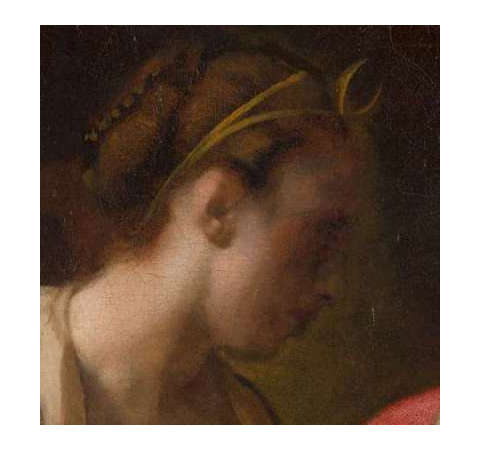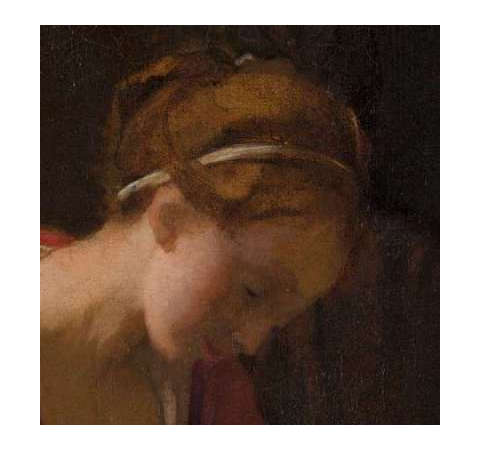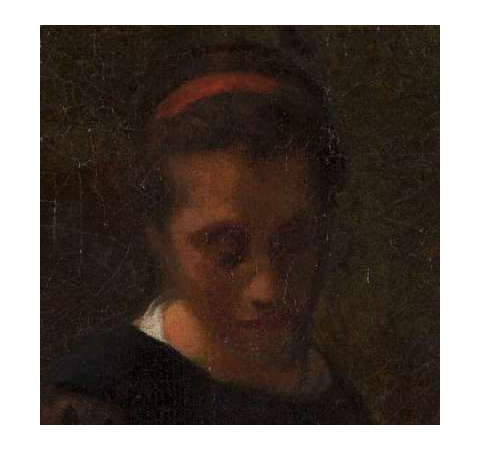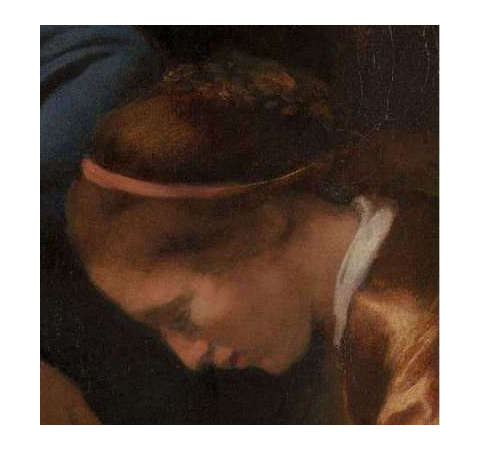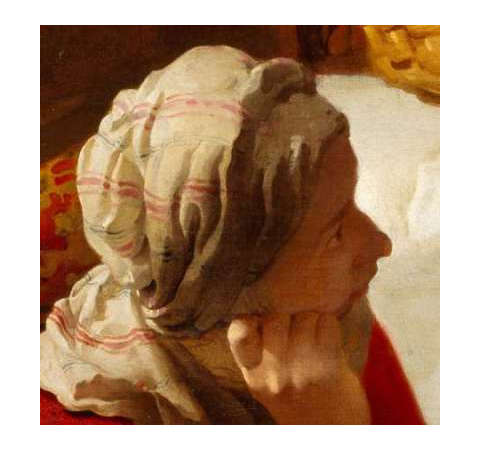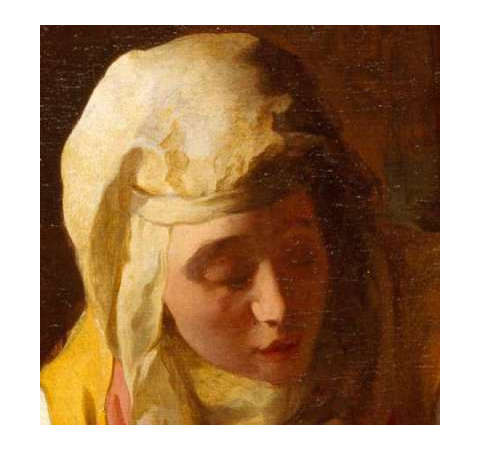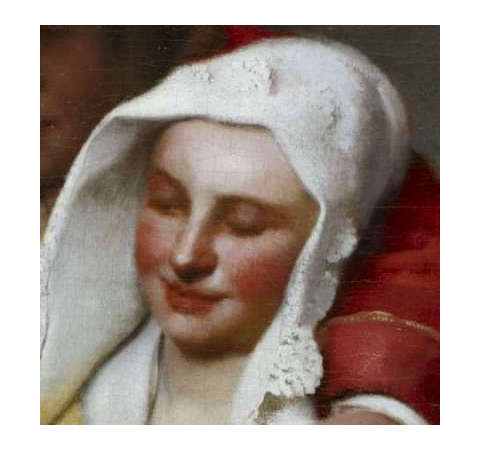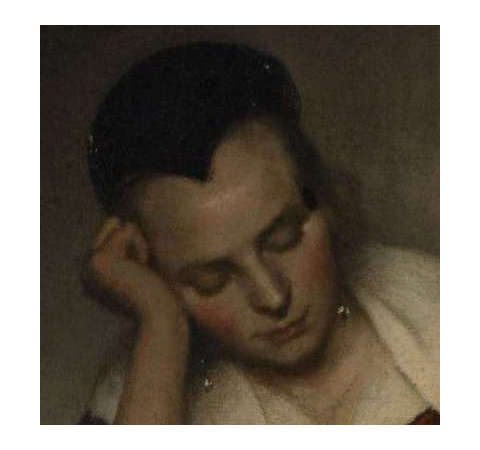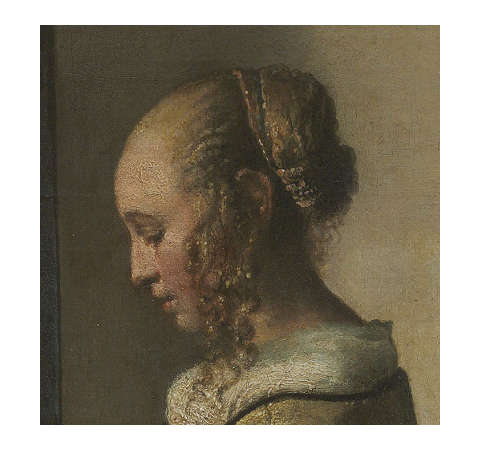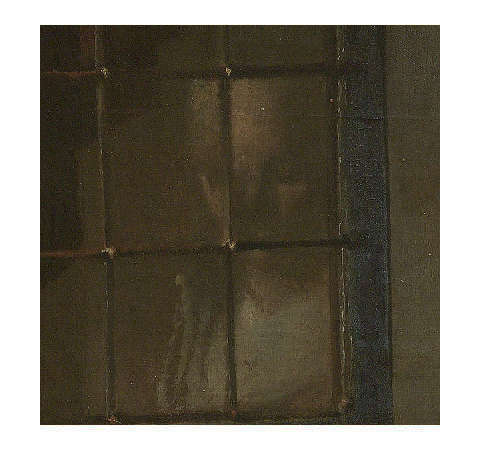Seventeenth-Century Dutch Women
In the seventeenth-century Dutch Republic, women enjoyed a set of rights and privileges that set them apart from their European contemporaries, especially those in France and Germany. Under Dutch law, married women could still own property in their own name, separate from their husbands. This gave them more economic autonomy than their counterparts in other countries where, upon marriage, a woman's property often became the legal possession of her husband. Dutch women could also engage in business and trade, enter into contracts, and participate in other financial activities, although in practice, this was more common among widows and single women than among married women whose husbands were alive.
While it was generally expected that the husband would manage the family's financial affairs, the wife had the right to act independently in legal matters concerning her own property. Moreover, the system of "community of property," commonly practiced in the Dutch Republic, stipulated that property acquired after marriage was jointly owned and managed by both spouses.
This level of autonomy extended to the business world, where they could manage enterprises, particularly if they were widows. Unlike in France and Germany, Dutch law required mutual consent for marriage and gave both spouses legal claim to property.
In society, Dutch women played significant roles beyond the household. They managed homes, participated in family businesses, and even had limited access to trade guilds. Their French counterparts, particularly aristocratic women, could run salons and thus exert some influence over intellectual and political discourse, but this was more a privilege tied to social class rather than gender. German women, on the other hand, had fewer educational opportunities and were generally confined to domestic roles, with fewer legal provisions for personal independence.
Family life in the Dutch Republic was somewhat progressive for its time. Marriages were often affectionate, divorce was possible though not common, and women usually married in their mid-to-late twenties—a relatively late age compared to other European norms. While families weren't particularly large, averaging two to four children, Dutch women who survived the rigors of childbirth—which remained one of the era's greatest health risks—could expect to live into their 50s or 60s.
The unusually high level of legal and economic autonomy, especially when compared to their European peers, allowed Dutch women to be active participants in both the domestic and public spheres, enjoying rights and opportunities that were extraordinary for the era.
The women that Vermeer painted are displayed below in chronological order.
About Vermeer's Women
During the course of his brief 20-year career, Vermeer probably painted no more than 60 paintings, 36 (the exact number is debated) of which have come down to us today. Few other Dutch painters produced so few pictures. In Vermeer's compositions, women appear in one guise or another about 46 times, while men make only 14 appearances, mostly in subordinate roles, three times with their backs to us. Two lost paintings by Vermeer portrayed men, a self portrait and a "man washing his hands, both listed in the 1696 auction catalogue of 20 paintings by Vermeer.
Critics have often noted that the women in Vermeer's paintings cannot be considered beauties in the conventional sense. Their beauty, instead, derives from the way they are painted and from the harmonic context in which they inhabit. "The qualities that we attribute to Vermeer's work as a whole apply equally to the women they picture: paintings and personages share dignity, equilibrium and an exceptional sense of both vivid presence and abstract purity. The figures range from girlish to maternal, yet all are youthful, with high curved foreheads, features that evenly balance the individual and the classical, and simple believable postures. Their costuming—its coloring, shapes and associations contributes so much to bodily construction and expression that the absence of nudes from Vermeer's's oeuvre hardly seems surprising."Lisa Vergara, "Perspective on Women in the Art of Vermeer," in The Cambridge Companion to Vermeer, ed. Wayne Franits (Cambridge: Cambridge University Press, 2001), 54–55.
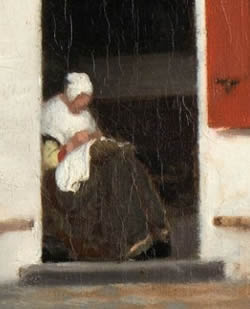
Johannes Vermeer
c. 1657–1661
Oil on canvas, 54.3 x 44 cm.
Rijksmuseum, Amsterdam
None of the women who modeled for Vermeer's paintings have ever been identified even though some seemed to have posed more than once. Other than the dresses and jewelry they wore and the poses that Vermeer instructed them to hold, we know nothing else about their lives. Modern scholarship generally holds that they were not painted as portraits except, perhaps, A Lady Writing in Washington. Even Vermeer's four bust-length figures, including the illustrious Girl with a Pearl Earring, were not intended as portraits, but tronien.
Vermeer's women were protagonists of a type of painting now called genre interior which was pioneered in the Netherlands during the first half of the seventeenth century by artists like Dirck Hals (1591–1656) and William Duyster (1599–1635). In these pictures, a number of young people are represented dressed in the latest and costliest fashions engaged in frivolous activities such as drinking, gaming and music-making. During the second half of the century, the number of figures was reduced greatly and the former high-spirited interiors evolved into the kind measured, luminous interiors in which subtle nuances gesture, texture and light were explored. These interiors brought to formal and technical perfection by artists like Gerrit ter Borch (1617–1681) and Pieter de Hooch, and only successively by Vermeer.
New Women In New Spaces
"Most of the genre paintings produced in this period take place in an interior, generally inspired by elegant homes of the middle classes. They reflect concepts that were important to the Dutch culture such as family, privacy, intimacy, comfort and luxury, encouraging the spectator to think about issues relevant to his or her daily life, sometimes with touches of humor. Both from an anthropological and viewpoint as well as an architectural and decorative one, they acquired and enormous importance in Holland in the second half of the seventeenth century: the physical space of the upper middle classes: the physical space of the of the upper middle classes expanded as the consequence of their growing wealth, dividing itself up into more spaces and offering to its inhabitants greater comfort and more private areas."Alejandro Vergara, "Vermeer: Context and Uniqueness Dutch Paintings of Domestic Interiors, 1650–1675," in Vermeer and the Dutch Interior (Madrid, 2003), 204. In these private spaces, women acquired a new importance.
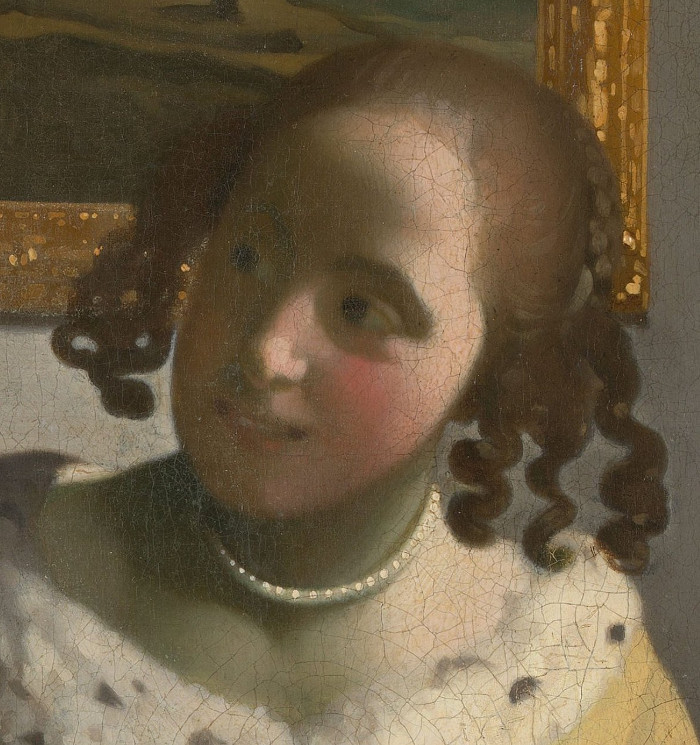
Johannes Vermeer
c. 1670–1673
Oil on canvas, 53 x 46.3 cm.
Iveagh Bequest, London
"The emphasis on women is logical in the work of an artist who was entirely devoted to the painting of interiors, as the domestic space was the realm which society had assigned to woman. Nonetheless, while for De Hooch and Maes the, home was the setting for maternity and domestic tasks, Vermeer was alert to the appearance of a new type of woman, better educated than her predecessors and more absorbed in her interior life. It is not by chance that among the innovations of interior paintings we find a sensibility towards the intimate psychology of individuals, given that the concept of an interior life was developing at just this time. Street life and family life became more separated in houses at this period and more private spaces and areas for withdrawing had begun to appear. Although these were generally reserved for men, Vermeer's women often seem to contain the moral and intellectual intensity which is associated with psychological introspection."Alejandro Vergara, "Vermeer: Context and Uniqueness Dutch Paintings of Domestic Interiors, 1650–1675," in Vermeer and the Dutch Interior (Madrid, 2003), 206.
A Special Woman in Vermeer's Life: A New Look at Maria de Knuijt
Piet Bikker and Judith Noorman presents a well-supported case that Maria de KnuijtDe Knuijt was baptized on 21 December 1623. She had a brother Vincent (1620–1664), a shopkeeper who owned several houses and outside of Delft he owned land. They had two brothers named Willem who both died the years of their birth in 1622 and 1627. The Van Ruijvens and De Knuijts were Protestants. Simon, her father, owned two houses on the Markt north-side, just west of the Mechelen inn. In 1656, the year of his death, be bought and then sold a house on Oude Langendijk—West of Molenpoort.—not her husband, Pieter van Ruijven—was the true driving force behind the collecting of Vermeer’s paintings.Piet Bakker and Judith Noorman, "Women’s Vermeers: Maria de Knuijt and New Archival Documentation on Vermeer’s Primary Patron," in Closer to Vermeer: New Research on the Painter and His Art, ed. Francesca Gabrieli et al. (Amsterdam: Rijksmuseum; Ghent: Hannibal Books, 2023), 146–157. This argument, which challenges long-standing assumptions in Vermeer scholarship, is grounded in both archival evidence and a reconsideration of social and legal norms of the time.
Noorman and Bakker uncovered two previously unknown codicils authored by Maria de Knuijt, both drawn up by notary Claes Verruyt in Leiden. These documents had never before been discussed in the Vermeer literature and add significant weight to the argument that De Knuijt—not her husband, Pieter van Ruijven—was Vermeer’s primary patron and a discerning art collector in her own right.
The Two New Codicils:
- First codicil:
Dated 3 July 1662, this document contains a range of bequests but does not mention Vermeer. However, it does mention most of the individuals who appear again in the 1664 codicil, indicating continuity and a formal approach to estate planning. - Second codicil:
Dated 9 June 1664, this is the more consequential of the two. It contains:
A personal bequest of 500 guilders to Johannes Vermeer, conditional upon De Knuijt outliving both her husband and daughter. The sum was expressly designated for Vermeer alone, and would not be transferred to anyone else if he predeceased her. This underscores the personal nature of her relationship to Vermeer, and her recognition of his artistic and financial dependency on her.
A bequest to Nicolaes van Assendelft, the couple’s legal representative and eventual commissioner in the settlement of Vermeer’s estate. She allowed him to choose any painting from her collection after her death—an honor typically reserved for trusted friends or fellow collectors. The bequest implies that both shared a genuine passion for art, and that De Knuijt’s collection had considerable personal and aesthetic value.
Significance:
Direct support of Vermeer: These codicils show that De Knuijt’s relationship with Vermeer was not merely transactional. The continuation of the bequest into the 1665 codicil (already known to John Michael Montias) confirms a consistent, long-term commitment to Vermeer’s welfare.
Independent legal action: That De Knuijt made these provisions on her own, without her husband, and with a notary in a different city (Leiden), highlights her legal agency and personal initiative in supporting Vermeer and curating her legacy.
Artistic agency of women: The codicils provide rare, documented evidence of a 17th-century Dutch woman acting independently as a patron and collector. Noorman and Bakker argue that the widespread assumption that Van Ruijven was the principal collector needs to be revised; the evidence suggests it was De Knuijt who was behind the purchases and patronage. Her estate, not her husband’s, ultimately contained the twenty Vermeer paintings that passed down through her daughter.
Challenging gender assumptions: The authors emphasize that art historians have too often attributed art ownership to men, especially in cases of joint inventories. These documents call for a reevaluation of such assumptions and highlight how women like De Knuijt exercised cultural power through collecting and patronage.
Were some of the Women in Vermeer's Paintings Pregnant?
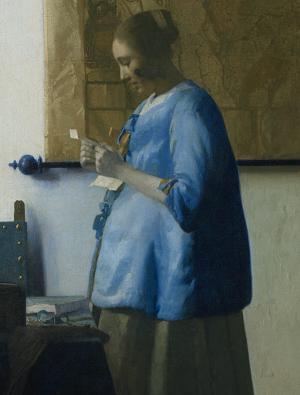
Johannes Vermeer
c. 1662–1665
Oil on canvas, 46.5 x 39 cm.
Rijksmuseum, Amsterdam
Pregnant women are relatively rare in the genre paintings of the seventeenth-century Netherlands,Seventeenth-century Dutch w omen did not typically hide their pregnancies in public but would adapt their clothing as their bodies changed. Maternity clothing was often designed to be adjustable to accommodate a growing belly. For instance, garments might feature lacing or ties that could be loosened which often depicted idealized or moralizing scenes of daily life. However, the fact that they are not commonly featured in artwork does not necessarily reflect a societal desire to hide pregnancy; it may simply be a function of the themes and subjects that were considered appropriate or interesting for artwork at that time.In the Netherlands, m edical understanding of pregnancy in the seventeenth century was limited compared to today, and maternal mortality rates were high. "Childbed fever," for example, was a common and often deadly affliction. Despite these risks, childbirth was considered a natural process, and the majority of births were overseen by midwives rather than physicians.
Even though to the modern eye three or perhaps four womenWoman with a Pearl Necklace, Woman Holding a Balance, The Concert, Woman in Blue Reading a Letter in Vermeer's paintings appear to be pregnant, there is good reason to believe that this was not the case. According to the Dutch costume expert Marieke de Winkel, pregnancy "was not a common subject in art and there are very few depictions of maternity wear. Even in religious paintings such as the Visitation, where depictions of pregnant women is required, the bodies of the Virgin and Saint Elizabeth were usually completely concealed by draperies."Marieke de Winkel, "The Interpretation of Dress in Vermeer's Paintings," in Vermeer Studies, eds. Ivan Gaskell and Michiel Jonker (Washington D.C.: National Gallery of Art; New Haven and London: Yale University Press, 1998), 327. De Winkel submits that to her knowledge "there are no examples of or pregnant women in Dutch portraiture, an interesting fact considering that many women were painted in their first year of marriage, a time when they could have been with child." Pregnancy was most likely not seen as aesthetically attractive. However, it should be mentioned that in a full-length pendant of Marten Soolmans and Oopjen Coppit painted by Rembrandt in 1634, Oopjen appears to be visibly pregnant: she gave birth to her first child shortly after the picture was finished.
Arthur K. Wheelock Jr. has written that "Dutch fashions in the mid-seventeenth century seem to have encourage a bulky silhouette. The impression of the short jacket worn over a thickly padded skirt creates in Vermeer's paintings just such an impression."Arthur K. Wheelock Jr. and Ben Broos, Johannes Vermeer (London and New Haven: Yale University Press, 1995), 196, n13. It is interesting to note that in the 1696 Dissius auction in which 21 paintings by Vermeer were sold, the Woman Holding Balance was described as "A young lady weighing gold, in a box, by J. van der Meer of Delft, extraordinarily artful and vigorously painted." Since pregnancy was not portrayed in Dutch painting of the seventeenth century, it is odd that the catalogue's author would not have noted such an exceptional fact. Afterward, no mention of the woman's pregnancy in relation to Vermeer's paintings can be found until 1971, despite the fact that the work can be traced in an almost unbroken line to this century.
Modern scholars generally believe that Vermeer systematically drew upon fellow genre painters of the time such as Gerrit ter Borch, Frans van Mieris, and Gerard Dou for both his compositions and themes. He did not substantially subvert or even significantly widen established iconographical boundaries, but rather seemed completely absorbed in realizing their fullest expressive potential. In this light, it seems doubtful that Vermeer addressed such an unconventional theme such as that of a pregnant woman.
Comments by Art Critics
The following interpretations range from finely reasoned contextual studies of the life and times of Vermeer by Mariët Westermann, to the ultimately subjective, but nonetheless indispensable, interpretations of Lawrence Gowing and Edward Snow. Also, what now seems a remote "art-for art's-sake" view of Vermeer's models as nothing more than illuminated surfaces, are also included and perhaps should not be dismissed so easily by the information provided by the last 20 years of intense iconographic studies. The entries are arranged in reversed chronological order.
Marjorie E. Wieseman
"Women of the Dutch Republic: Genre Painting and Soceity in the Second Half of the Seventeenth Century" in Johannes Vermeer: On Reflection, ed. Stephan Koja and Uta Neidhardt (Dresden: Sandstein Verlag, 2021), 64.
Focusing largely on the leisured existence enjoyed by the uppermost strata of seventeenth-century Dutch society, genre paintings by Johannes Vermeer and his contemporaries offer a highly edited and subjective view of Dutch womanhood. For too many Dutch women in the early modern era, life was an endless cycle of labor, poverty, disease, and disappointment. By contrast, the paintings' beautiful fictions typically revolve around well-to-do young women leading untroubled lives in comfortable domestic surroundings. Confident in their wealth and social privilege, they engage in a prescribed range of genteel activities: courtship, conversation, childcare, music-making, needlework, reading, writing, and attending to their personal appearance; they are rarely seen venturing outside the home. This essay looks at some of the issues shaping women’s everyday lives in the seventeenth-century Dutch Republic—rights and restrictions, literacy, labor, and relations with the opposite sex—to consider to what degree those realities are reflected in genre paintings by Vermeer and others.
In addition to their narrow socioeconomic focus, Dutch genre paintings of the second half of the seventeenth century often exhibit an inherent gender bias. Virtually all were created by male artists, and, while viewed and enjoyed by both men and women, they were likely directed towards a predominantly male audience: this undoubtedly determined how (and which) feminine narratives were presented. Nor is history itself free of bias. Modern historians' understanding of seventeenth-century Dutch society is generally derived from an analysis of archival documents (reasonably objective, but fragmentary in scope) and contemporary literature, including the published observations of (predominantly male) moralists and travel writers, each of whom brought their own prejudices and preconceptions to bear. A more balanced view of seventeenth-century women's lives is difficult to achieve, as writings by women about women during the period are rare, and few female artists applied their talents to exploring similar themes in genre painting.
Lawrence Gowing
Vermeer, Oakland CA: University of California Press, 1997, 43-44.
Thus it comes about that we see Vermeer building the ideal shape of domestic and feminine life. The representation, the construing ever more closely of the aspect of the beloved as it moulds her mask of light, is also an independent, intact construction of the essential forms of female being, in their permanence. Looking back again to that first appearance of so much that is most deeply Vermeer's own, we find its beginnings in The Music Lesson. As if in visible lifting of the naturalistic burden the outer skirt of the lady who stands at the virginals, like that of the Maidservant, is drawn up in the common fashion, and beneath it is seen another. This lower skirt hangs in regular, vertical folds; it is fluted and independent as a column, one whose capital momentarily shows itself in the curled volutes of the head-dress. Nothing intimate is uncovered. This is the unveiling of an impersonal core, the emergence of a principle which has been latent, held in reserve, since the Dresden Letter Reader. It is the discovery in female physique of the rhythmless quality of a monument. All its development is implicit here. We may foresee its growth, its accumulation of meaning until it appears entire, standing free in its final shape, the shape of the servant in the Dublin Letter Writer and the Lady Standing at the Virginals.
This is the particular theme of the pearl pictures, a gentle stillness of stature. The shape is vertical. The figure appears, tender and immaculate, out of the cleft shadow of the cumbrous furniture; it is rooted in it, rooted, as we see at last, utterly unmoving, to the floor. And besides this upright shape, this pillar, we come to know another, its antithesis that nevertheless easily and equally combines with it. It is the shape of a bell. It is noticed as the shape of the raised skirt in The Music Lesson. More essentially we remember it as the shape of rounded shoulders which is often the stooping shape of preoccupation, of a woman bent attentively over a table. It has a feminine quality of self-possession: in retrospect we realize that some of the incongruity of the conversation pieces, the first crude formulations of attentiveness, was that there it was applied to the egregious cavaliers. It is the shape which identifies itself, in The Concert, the Lady Weighing Gold and the Amsterdam blue Letter Reader at least, as the draped body of a woman with child.
Mariët Westermann "Vermeer and the Self Aware Interior," in Vermeer and the Dutch Interior, ed. Alejandro Vergara, Madrid, 2003, 229.
Even if Vermeer gives us hints about the narrative that may have led to the moment represented in his pictures of readers and writers—pregnancy in the Woman in Blue Reading a Letter, a crumpled letter on the floor in front of the desk in the Lady Writing a Letter with her Maid—he gives us no clues as to its denouement. As so often in Vermeer's work, we have a sense of proto-cinematic suspense, in that we have no indication of what the next frame will show. What all his writing and reading women have in common, however, is a capacity for absorption in a text, and thus for independent thought. This mental ability is figured not merely by the theme of writing and reading or by averted gazes. Vermeer established the seriousness of these women about literate activity with great pictorial subtlety, as it were making his own thoughtful compositions stand for the mental activity of his actors. It is surely no accident that the vanishing point in the Lady Writing a Letter with her Maid lies precisely in her left hand, which is rigorously focused on the task of writing. The figure in Woman in Blue Reading a Letter is anchored in a geometrically calibrated composition, restricted in color, that forces our focus on the woman's face and letter, thus on her act of reading.
Anthony Bailey
Vermeer: A View of Delft, New York, 2001, 121–123.
Rather than feeling the need to rebel against women in his house, Vermeer seems rather to have been absorbed in them. The feminine enveloped him and he was a willing and happy victim. Although not all the women he painted are conventionally good- looking, he apparently liked painting women's skin and their clothes and accouterments. Did he say to them, "Please wear such-and-such a dress," "Those pearl earrings today," or "Do your hair with those blue ribbons—they make you look so pretty"? Or did he take them as they come, perhaps already dressed for the occasion, dressed for him? He enjoyed catching the self-regard of a young woman looking in a mirror as she put on a necklace. The challenge of portraying the folds in the much seen yellow jacket or the sheen, shadows and creases of the red dress worn by the Girl being offered Wine clearly excited him. (The result was art, otherwise one might have said it sexually excited him.) His repertoire included many of the means women employ to hold on to male interest, from the devoted care, both practical and spiritual, that Martha and Mary had shown, to more enticing types of attraction, such as subtleties of hair-do. Hair is pulled straight back from the forehead, held in place with bows, tied in a bun or braided in a chignon -these are the ways of arrangement in A Lady Writing; in the young woman playing the keyboard instrument, a clavecin, in The Concert; of the mistress in the Mistress and Maid; and in the Woman with a Pearl Necklace. Ringlets are the favored style in The Lacemaker, in the Girl Reading a Letter at an Open Window (who also has a chignon), and in The Guitar Player. Other women have their heads modestly covered with scarves or hoods, or wrapped in a silk turban, like the Girl with a Pearl Earring.
Lisa Vergara
"Perspectives on Women in the Art of Vermeer," in The Cambridge Companion to Vermeer (Cambridge Companions to the History of Art), edited by Wayne Franits, Cambridge, 2001, 62.
Regarding the concept of figuration in the Woman Holding a Balance, it is useful to consider some remarks made by Vermeer's fellow painter, Samuel van Hoogstraten (1627–1678). In his long treatise on art, Van Hoogstraten writes that if a painting is to reach the highest level (the third level, in his scheme), then it must show the noblest emotions and desires of rational human beings. The talent needed to depict more than "mere animal passions," Van Hoogstraten feels, is spread very thin. Interesting in this context is the fact that he cites painters of "the loveliest young women in every town." He writes (abruptly turning to portraiture): "Indeed, those portrait painters who make reasonable likenesses, and imitate eyes and noses and mouths all prettily, I would not wish to place…above the first grade, unless they make their faces overflow with the quality of the intellectual soul…" The Woman Holding a Balance demonstrates that Vermeer's achievement is of the highest rank, because through his figure's display of womanly judiciousness, her seemingly blessed maternal state, her visual associations with Mary, her confidence in the face of Judgment, we do indeed get a sense of what Van Hoogstraten called "the noblest emotions and desires of rational human beings." Further, as in all of Vermeer's paintings (and this separates them from works by his contemporaries), here the window reveals no view outside. The woman's resulting privacy within the enclosed interior becomes a metaphor for her own interiority, her own soul within.
Reviewing his cast of female characters, we can easily see how often Vermeer suggests through them the workings of the mind and the cultivation of the spirit that come together in the course of commonplace yet highly civilized activities. Not surprisingly, his women express habits of mind, hand and heart akin to those we imagine the artist himself exercising as he planned and painted his pictures. This certainly pertains to the Woman Holding Balance. For example, Edward Snow, prompted by the fact that the pans of the scale are empty except for gleams of light, observes of the woman's action: "It seems appropriate that a gesture so paradigmatic of Vermeer's art, should appear concerned with the weighing and balancing of light itself." Indeed, the gesture requires precise coordination of delicate physical and mental calculations the same capacities that Vermeer's art demanded from him. In The Milkmaid, the figure's act of directing a stream of liquid straight downward brings to mind one of Vermeer's own most distinctive pictorial habits: the ensured, mimetic application of paint (here representing milk) over carefully plotted straight lines. No wonder his perspectives on women tend to strike viewers as sympathetic; consistently, the figures' gestures refer back to the very processes of his art. Even in the case of male characters, Vermeer avoids actions more readily associated with masculinity, those requiring physical exertion, vigorous motion, forceful contention.
Edward Snow
A Study of Vermeer, Berkeley, Los Angeles and London, 1979, 35–36.
In the majority of the early paintings, the depicted situation itself provides the occasion for what tends to be a negative identification on the part of the artist: men either paying court to or supervising women, waiting upon them-worldly, overshadowing, equivocally motivated visitors who are usually encumbered and ill-at-ease in a space that tends for the woman to be a natural, often aggressively protective habitat.
Vermeer's capacity for negativity is uncomfortably evident in the three closely related genre scenes, Woman Drinking with a Gentleman, Gentleman and Girl with Music, and the Brunswick Couple with a Glass of Wine. In these paintings, the attention that man pays to woman—acutely isolated by Gowing as the theme of all Vermeer's work—elicits from the painter a deliberately acid response. All three give the impression of unhappily willed failures, rather than just immature or otherwise inadequate attempts at a conventional genre scene.
